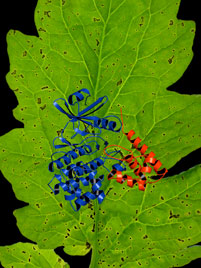Researchers discover how pathogen causes speck disease in tomatoes

Researchers have discovered how the structure of a protein allows a certain bacteria to interfere with the tomato plant's immune system, causing bacterial speck disease.
The work helps explain how Pseudomonas syringae, a bacterial pathogen, has evolved to cause disease and may open the door to breeding tomato varieties that are resistant to speck disease, which can prompt costly losses in tomato crops.
The research -- conducted at the Boyce Thompson Institute for Plant Science (BTI) at Cornell in conjunction with scientists at Tsinghua University in Beijing -- is published in the December issue of the Cell Host and Microbe.

"Our work presents clear evidence of a molecular arms race or coevolution between a host plant and a pathogen," said Greg Martin, an expert on tomato disease resistance at the Cornell-affiliated BTI, a Cornell professor of plant pathology and plant-microbe biology, and lead author of the paper.
The paper describes the crystal structure of AvrPtoB -- a protein injected into plant cells by Pseudomonas syringae that interferes with the plant immune response and allows the bacteria to multiply. The paper also provides an understanding of how AvrPtoB binds and interferes with the plant protein BAK1, which acts with immune receptors to activate plant defenses.
Some tomato varieties are able to resist infection by Pseudomonas syringae because they express proteins Fen and Pto, which detect AvrPtoB and mount a defense.
The structures characterized in Martin's research revealed that two domains of AvrPtoB have a structural similarity, suggesting they arose from an ancestral avrPtoB gene. The paper also identifies part of BAK1 that is structurally similar to the defense protein Pto.
Martin's research is supported by the National Institutes of Health and the National Science Foundation.
Media Contact
Get Cornell news delivered right to your inbox.
Subscribe